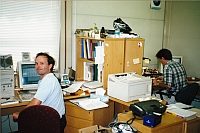A short history of the ASRP
Between 1992 and 2008, the Australian Synchrotron Research Program and its precursor (the Australian National Beamline Facility) enabled Australian researchers to achieve well over 4000 days of synchrotron beamtime at overseas facilities in the USA, Japan and Taiwan.
Without the ASRP, many of these experiments would not have been possible - and Australia would not have developed the synchrotron expertise that now plays such a vital role in supporting research and development projects across the nation.
ASRP was established in 1996 under the federal government's 1995 Major National Research Facilities (MNRF) program to provide Australian scientists with access to state-of-the-art synchrotron radiation research capabilities at overseas synchrotron light source facilities. ASRP was managed by ANSTO, Australia's national nuclear scientific research organisation. The MNRF program also funded a feasibility study for a domestic synchrotron facility, which set the basic parameters for the Australian Synchrotron.
ASRP built on the successful Australian National Beamline Facility (ANBF) project, which had operated Australia's first synchrotron beamline at the Photon Factory at the KEK Laboratory in Tsukuba, Japan, since 1992. It also facilitated access to the Advanced Photon Source in Chicago, USA, which was emerging as the world's premier hard x-ray third generation synchrotron facility. The program was extended to the National Synchrotron Radiation Research Center in Taiwan as well with funding from the 2001 MNRF program, which also provided for a versatile soft x-ray endstation at NSRRC. This endstation was relocated to the Australian Synchrotron in late 2007.
Funding was allocated on a peer-reviewed basis and ASRP placed scientists at the overseas facilities to assist visiting Australian researchers. From 30 experimental teams in 1997, the program grew to over 180 in 2007, eventually funding more than 1400 experiments and 3000 individual scientist visits (including ANBF activities). Australians gained access to well over 4000 days of synchrotron beamtime and produced many hundreds of publications.
In July 2008, the Australian Synchrotron assumed responsibility for Australian access to overseas synchrotrons. The ASRP Board met for the last time in September 2008.
ASRP fellows
The ASRP fellowship scheme supported 18-20 particularly talented Australian scientists who wanted to strengthen their synchrotron expertise.
ASRP staff
Over the years, key ASRP staff have included Dr John Boldemann (ASRP Director 1996-2002) and Dr Richard Garrett (ASRP Scientific Manager 1996-2002 and Director 2002-08).
 |
First light on the ANBF beamline in 1992. Garry Foran lines up for the first diffraction pattern. |
 |
L to R: Garry Foran, Richard Garrett and David Cookson, who installed the ANBF beamline in Japan in 1992. |
 |
When the ASRP was formed, James Hester replaced David Cookson at the ANBF. Garry Foran is pictured at right. |
 |
The signing ceremony at the APS in 1996 when ASRP joined the then SRI-CAT and CARS beamline consortiums. L to R: Gopal Shenoy (APS), Helen Garnett (Executive Director, ANSTO), Richard Garrett (ANSTO), Denny Mills (APS), John Boldeman (ANSTO) and Dave Moncton (Director, APS). |
